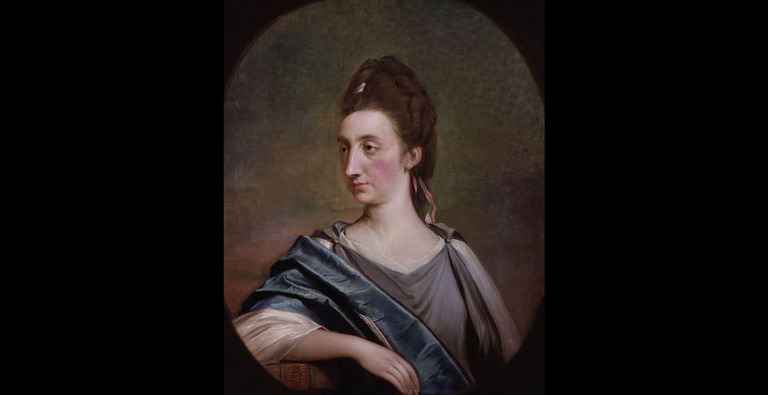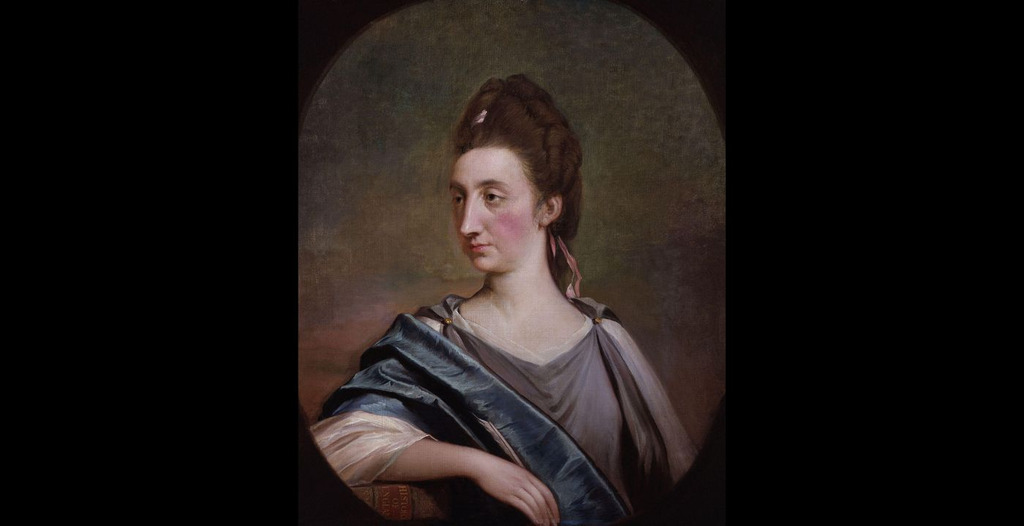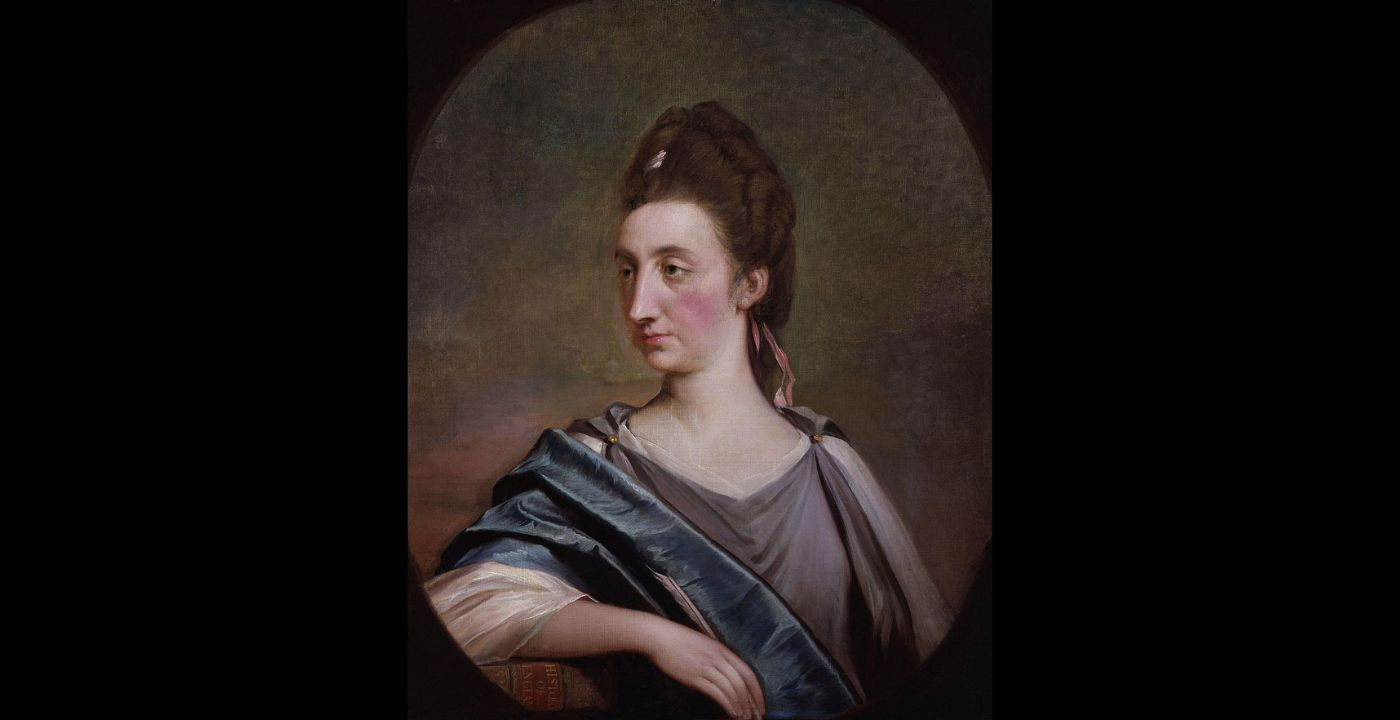Birth
April 2, 1731 (March 23, 1730 oJohn ld style), Kent, UK.
Education
Catharine Sawbridge and her sister were educated at home by a governess, Mrs Fuzzard.
Death
June 22nd, 1791 in Berkshire, UKReligion
Variable, Unitarian, AnglicanCatharine Macaulay Graham was a British historian and political writer. She is most famous for the eight-volume A History of England from the Accession of James I. to that of the Brunswick Line. In the 1760s, she was the foremost British advocate for equal rights. Though famous during her lifetime, she was largely forgotten after her death.
Personal Information
Name(s)
Born, Catharine Sawbridge, became Catharine Macaulay at first marriage, then Catharine Macaulay Graham after second marriage.
Date and place of birth
April 2, 1731 (March 23, 1730 oJohn ld style), Kent, UK.
Date and place of death
June 22, 1791, Berkshire, UK.
Family
Mother:
Dorothy Wanley, born November 15, 1713 daughter of George Wanley, a Fleet St Goldsmith. Died March 15, 1734 (March 4, 1733 old style).
Father:
John Sawbridge, born 1699, son of Jacob Sawbridge (1672–1748) a banker and director of the South Sea Company. After the death of his second wife, Dorothy, Sawbridge seems to have spent most of his time in London, while his four children by Dorothy (Dorothy (1729–1798), Catharine, John (1732–1795), and Wanley (1733–1796) remained at Olantigh in Kent, in the care of his brother, Jacob Sawbridge (1700–1763), who had married Anne Brodnax (1709–1754) of the neighbouring estate, Godmersham. Anne Brodnax was the sister of Thomas Knight (1701–1781) who had changed his name from Brodnax to Knight to secure an inheritance. His son, also Thomas Knight (1735–1794), adopted Edward Austen (1768–1852), elder brother of Jane Austen (1775–1817), who ultimately inherited Godmersham.
Marriage and Family Life
Catharine Sawbridge wed George Macaulay (1716–1766), widower and male midwife/physician, on June 20, 1760 at Wye. One witness to the marriage was Stephen Beckingham (1729–1813), who had been married to her elder sister, Dorothy on February 28, 1758. The other was one of the Thomas Knights.
With George Macaulay, Catharine moved to London to a house in St James Place, Westminster and began to publish her History of England from the Accession of James I. A fair copy of the first volume was completed in November 1763 and was printed that year. The second volume appeared in 1765. Her husband settled an independent income on her and clearly supported her historical endeavours. While living at St James Place the Macaulays entertained both the conservative Samuel Johnson and republicans such as Thomas Hollis, who lived close by. Another friend was David Steuart Erskine, whose father had been a great friend of George Macaulay’s father, Archibald, who had been Lord Provost of Edinburgh and Lord Conservator of the Scott’s Privileges at Campvere, Netherlands. Erskine was closely connected to William Pitt, who also had a town house close by during this period. Among other dinner guests at the Macaulay home were Sir William Young and his wife Elizabeth who was the daughter of her great-aunt Sabetta Sawbridge and the mathematician, Brook Taylor (1685–1731).
George Macaulay had studied medicine at Edinburgh and Padua and, in 1739, had graduated with a double doctorate from the latter university. He specialized in child-birth and was treasurer for the Brownlow St Lying in hospital, a charitable institution set up to assist poor women in labour. His sister had married a David Gregorie, a member of a large family of Gregories (or Gregorys), among whom were a number of professors of medicine and mathematics at Scottish universities. Thomas Reid’s mother was also a member of this family. Thomas Smollett, and, distantly, David Hume were further relations, so through her marriage Catharine was connected to the broad penumbra of the Scottish Enlightenment.
The couple had one child, Catharine Sophia, born February 24, 1765. Not long afterwards, in September 1766, George Macaulay died, leaving his wife a reasonably rich widow. She moved to a house in Berners St, off the Oxford Rd, and close to the British Library.
In November 1778 Catharine Macaulay was married to her second husband, William Graham (1757–1845) at Leicester. Graham was the younger brother of James Graham, a controversial doctor, and of Elizabeth Arnold, who had travelled with her to France in late 1777. This marriage, to a man twenty-six years her junior and her social inferior, led to an outpouring of salacious scandal mongering, and was represented as the triumph of passion over reason and of arbitrary domination over liberty. In fact, letters written by Catharine Sophia to William Graham after her mother’s death suggest that Graham took care of his wife, whose health was never good, and the period of her second marriage was one of great productivity.
Education
Catharine Sawbridge and her sister were educated at home by a governess, Mrs Fuzzard, who was later derided as being old fashioned and ignorant. She nevertheless developed an interest in reading, particularly republican history, for her father’s library was well stocked with accounts of the period of the English Civil War. She also read Roman History, in particular as recounted by Charles Rollin, and like many others, read Addison’s Spectator and possibly Haywood’s Female Spectator.
It is really quite unclear how Macaulay transformed herself from daughter of a wealthy middle-class family, whose life aspirations might have been expected to be marriage to a neighbouring land-owner, as expected in an Austen novel, into the foremost republican historian of her age, whose Letters on Education made a significant contribution to the genesis of Mary Wollstonecraft’s feminism. Both she and her sister married late, perhaps wary of marriage and childbearing, which had resulted in their mother’s early death. They only wed once the death of their father meant that Olantigh was to be passed on to their brother. When they married, they chose ‘enlightened’ husbands, who were both engaged in extensive charitable activities, and who had adopted modern ideas of marriage as a friendship between equals. George Macaulay, in particular, must be credited with having encouraged his wife’s aspiration to contribute to the dissemination of ideas of political justice and social progress through taking on the laborious task of writing the History of England.
Religion
Although she never officially left the Anglican Church, Macaulay was a close friend of Quakers and other dissenters and was an unofficial unitarian.
Transformation(s)
Macaulay set out in her History of England from the Accession of James I, to counter the conservative accounts of the English Civil War and parliamentary period that had recently been published by David Hume and Tobias Smollett. She hoped to defend the virtues of the republicans and to remind the people of Great Britain of the men and women to whom they owed their substantial political liberties. Whereas Hume and Smollett had derided the egalitarian aspirations of the Levellers, Macaulay represented their proposals for an elected assembly and a broad franchise as the most adequate form of political organization that had so far been suggested. Whereas they lamented the execution of Charles I as a tyrannical act of injustice, she defended the people’s right to try and execute the king on the basis of Miltonian and Lockean political principles. In his The Century of Revolution Christopher Hill observed that, ‘through the writings of Catherine (sic) Macaulay and others the ideas of the Levellers passed into the radical tradition of the seventeen-sixties, and played their part in preparing the American and French Revolutions’ (190). Indeed, one can say more strongly that during the 1760s she was the foremost British promoter of the equal rights of men and of the idea that ‘government is a power delegated for the happiness of mankind’ which should be ‘conducted with wisdom, justice, and mercy’. This statement graces the plinth, represented in a portrait of her, painted by Robert Pine in 1774, and was reproduced on a series of ceramic figurines, which took her message into the parlours of her admirers.
less
Significance
Works/Agency
The History of England from the accession of James I. to that of the Brunswick line, 8 vols London: Vols 1–4, Printed for the author and sold by J. Nourse, J. Dodsley and W. Johnston: Vols 5–8 Edward and Charles Dilly, 1763–83.
Histoire d’Angleterre; depuis l’avènement de Jacques I, jusqu’a la revolution, Translated by Mirabeau and Guiraudet, 5 vols Paris: Gattey, 1791–1792.
Loose Remarks on certain positions to be found in Mr Hobbes’s “Philosophical rudiments of government and society,” with a short sketch of a democratical form of government, In a letter to Signor Paoli, London: T. Davies, in Russell-street, Covent Garden; Robinson and Roberts, in Pater-noster Row; and T. Cadell, in the Strand, 1767.
Observations on a Pamphlet entitled ‘Thoughts on the Cause of the Present Discontents’, London: Printed for Edward and Charles Dilly, 1770.
A Modest Plea for the Property of Copy Right, Bath: R Cruttwell, for Edward and Charles Dilly, 1774.
Address to the People of England, Scotland, and Ireland on the Present Important Crisis of Affairs, London: Dilly, 1775.
History of England from the Revolution to the Present Time in a Series of Letters to a Friend, Bath: R. Cruttwell, 1778.
A Treatise on the Immutability of Moral Truth, London: A. Hamilton, 1783.
Letters on Education. With observations on religious and metaphysical subjects, London: C. Dilly, 1790.
Observations on the Reflections of the Right Hon. Edmund Burke, on the Revolution in France, in a Letter for the Right Hon. The Earl of Stanhope, London: C. Dilly, 1790.
Contemporaneous Identifications
Reputation. Macaulay was famous during her lifetime, and her foray into the serious discipline of history was taken to be a remarkable achievment, which should not necessarily be emulated by other women. Attitudes to her were both positive to the point of adulation and negative to vituperation. In general, her historical and political works were positively reviewed (especially in those cases where they were published anonymously) but her more philosophical works, the Treatise on the Immutability of Moral Truth and Letters on Education were less warmly received. An exception was the review of the latter work, by Mary Wollstonecraft, which was enthusiastic.
In America, in particular, it was claimed that her history was everywhere sought after, and she was praised as a defender of American liberty. She was also fêted as a ‘hater of kings’ on her short visit to France and was admired by Jacques-Pierre Brissot de Warville, his friend Marie-Jeanne Roland, and by Mirabeau, who arranged for the translation of her history into French.
Although her reputation suffered as a result of her second marriage, she was supported by the Lady’s Magazine, which published extracts of her works both before and after her second marriage.
Legacy and Influence
After her death, Macaulay quickly passed into obscurity. Her descendants preserved her correspondence but did not manage to publish it, nor did anyone republish her works. She seems to have been particularly unlucky in so far as a member of her husband’s clan, Thomas Babington Macaulay, took up the history of England from where hers had ended, publishing A History of England from the Accession of James II, so that by the twentieth century ‘the historian Macaulay’ was assumed to refer to Thomas Babington, not Catharine. Her work was known only to experts, such as Christopher Hill, whose wife Bridget was responsible for the first modern biography, The Republican Virago which appeared in 1992, and fostered the current growing recognition of the importance of Catharine Macaulay for the progress and development of democratic and feminist ideas.
During the nineteenth and early twentieth century descriptions of Macaulay were significantly coloured by the negative representations penned by her conservative detractors. The tags, ‘republican virago’ and ‘brood hen of faction’ fashioned by Edmund Burke and Horace Walpole respectively, conveyed the impression that she had been defective as a woman, and meddled beyond her appropriate sphere. Samuel Johnson’s story, in which he boasted of having refuted her levelling principles, by inviting her footman to sit down with them, and accounts of the fuss made over her forty-sixth birthday celebrations, trivialized the significant role she had played in promoting democratic ideals. Even Lucy Martin Donnelly and Bridget Hill’s pathbreaking accounts of her life were somewhat embarrassed and apologetic in tone. As a serious advocate and disseminator of republicanism and democracy during the eighteenth century, she almost disappeared from view. Discussion of her ideas was not to be found in any history of political thought. Her Letters on Education was re-issued in 1974, as part of a new wave of academic interest in the history of feminism, but it did not gain the traction acquired by Wollstonecraft’s Vindication of the Rights of Woman, which was also reissued around the same time. Slowly, during the second half of the twentieth century, female historians began to rediscover her works and influence, but it was not until the 1990s that more than a handful of studies were published.
As Bridget Hill’s biography was in press, a large quantity of Macaulay’s correspondence suddenly appeared and was auctioned by Philip’s Auctioneers. The bulk was purchased by the Gilder Lehrman Institute for American History, where it now resides. An edition of the correspondence was published by Oxford University Press in 2019 and brings into clearer focus the extent of her friendships and influence during the period leading up to the American and French revolutions.
There are few memorials to Catharine Macaulay. A commemorative medallion, commissioned by her second husband is found in the All Saints Church at Binfield Berkshire, where she was buried. A statue of her as Clio, by John Francis Moore, commissioned by Thomas Wilson, is in the Warrington Museum and Art Gallery.
Nevertheless, during her life she was well connected to other active intellectual women. Not far from Olantigh was the maternal home of the Robinson family, which produced two important literary women of the period, Elizabeth Montagu and Sarah Scott. They were well educated and acquainted with the Sawbridges, and may have provided early role models for Catharine, though Elizabeth, in particular, disapproved of her political views and possibly saw her as a social inferior. The region was also the home of Elizabeth Montagu’s friend, Elizabeth Carter, whose family lived at Deal. When Carter was soliciting subscriptions for her translation of Epictetus, the twenty-five year old Catharine Sawbridge accosted her, in order to subscribe, and they enjoyed a long intellectual conversation in the Canterbury Assembly Rooms.
While at Berners St, Macaulay entertained like-minded Londoners, including Horace Walpole, John Wilkes, Richard Price, Joseph Priestly, James Burgh, George Simon (Lord Harcourt), Caleb Fleming and the American visitors, Benjamin Franklin, Benjamin Rush, and Charles Lee. Enlightened French also dined with her, in particular the two dukes of Rochefoucault and she was acquainted with the Chevalier d’Eon. She was close friends with the Quaker, Mary Knowles. Through the joint agency of the widow of John Mayhew and Thomas Hollis, she became the correspondent of the notable American women, Sarah Gill, Abigail Adams, and in particular, Mercy Otis Warren.
Among her correspondents one also finds Hannah More, who came to strongly disapprove of the both the French revolution and of the language of the ‘rights of woman’ but who included Macaulay among the women praised in her early poem, ‘The Bas Bleu; or Conversation’.
Although there is no evidence of a direct friendship, Laetitia Barbauld and Catharine Macaulay had many mutual friends, in particular Joseph Priestley and Richard Price, as well as similar interests in political reform. James Burgh and his wife, Hannah Burgh, who helped Mary Wollstonecraft set up a school in Newington Green were among her friends, and it may well have been in virtue of this connection that Wollstonecraft sent a copy of her Vindication of the Rights of Men, with a flattering letter, to Macaulay, just prior to the latter’s death. Mary Hays did her best to keep the memory of Macaulay alive, writing the long account of her life included in her Female Biography, which remains one of the most important sources for her biography.
less
Bibliography
Primary (selected):
The History of England from the accession of James I. to that of the Brunswick line, 8 vols London: Vols 1–4, Printed for the author and sold by J. Nourse, J. Dodsley and W. Johnston: Vols 5–8 Edward and Charles Dilly, 1763–83.
Histoire d’Angleterre; depuis l’avènement de Jacques I, jusqu’a la revolution, Translated by Mirabeau and Guiraudet, 5 vols Paris: Gattey, 1791–1792.
Loose Remarks on certain positions to be found in Mr Hobbes’s “Philosophical rudiments of government and society,” with a short sketch of a democratical form of government, In a letter to Signor Paoli, London: T. Davies, in Russell-street, Covent Garden; Robinson and Roberts, in Pater-noster Row; and T. Cadell, in the Strand, 1767.
Observations on a Pamphlet entitled ‘Thoughts on the Cause of the Present Discontents’, London: Printed for Edward and Charles Dilly, 1770.
A Modest Plea for the Property of Copy Right, Bath: R Cruttwell, for Edward and Charles Dilly, 1774.
Address to the People of England, Scotland, and Ireland on the Present Important Crisis of Affairs, London: Dilly, 1775.
History of England from the Revolution to the Present Time in a Series of Letters to a Friend, Bath: R. Cruttwell, 1778.
A Treatise on the Immutability of Moral Truth, London: A. Hamilton, 1783.
Letters on Education. With observations on religious and metaphysical subjects, London: C. Dilly, 1790.
Observations on the Reflections of the Right Hon. Edmund Burke, on the Revolution in France, in a Letter for the Right Hon. The Earl of Stanhope, London: C. Dilly, 1790.
Archival resources (selected):
Beinecke Library, Yale University (letters)
Bodleian Library, Oxford (letters)
British Library, London (ms of the history)
Gilder Lehrman Institute for American History, New York (letters)
Houghton Library, Harvard University, Boston (letters)
Leicester City Museum and Art Gallery, Leicester (letters)
New York Public Library, New York (letters)
New York Historical Society, Patricia D. Klingenstein Library, New York. (ms of the history)
Massachusetts Historical Society, Boston (letters)
Rhode Island Historical Society, Newport, Rhode Island (letters)



Comment
Your message was sent successfully